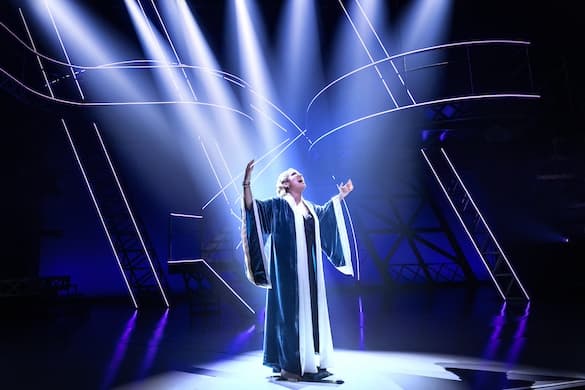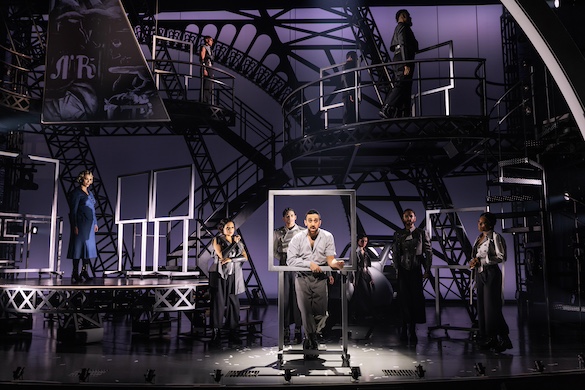A New Broadway Musical, ‘Lempicka,’ Offers Opportunity To Get To Know an Art Deco Icon
The titular artist, Tamara de Lempicka, is cursed to live in interesting times, fleeing both revolutionary Russia and Hitler-era Europe, and is burdened with the additional challenges of being a woman, and bisexual.

One of the greatest musicals of the past 50 years, “Sunday in the Park with George,” focused on a 19th century painter, Georges Seurat, and, more generally, on the creative and personal struggles faced by driven artists. In the new musical “Lempicka,” the titular artist is burdened with the additional challenges of being a woman, and bisexual — and by being cursed to live in interesting times.
Before Tamara de Lempicka’s vibrant uses of color, line, and form made her an Art Deco icon, she was forced to flee revolutionary Russia with her wealthy husband, Tadeusz Lempicki, whose release she somehow finagled after he was arrested by the Bolsheviks. They landed at Paris, where Lempicka’s bold, bright portraits — among them nudes — appealed to both the aristocrats, who were often her subjects, and the fringes who fed her adventurous spirit.
Hitler’s ascent made Lempicka, whose father was Jewish — her descendants would learn that her mother was born into that religion as well — a refugee again: In 1939, she and her second husband, Baron Raoul Kuffner, relocated to America. This is where we first meet her in “Lempicka,” sitting on a Los Angeles park bench nearly four decades later, bemoaning the lack of culture surrounding her.
Tamara still has her memories, though, of the beauty that will soon unfold onstage as her life is revisited — and of something else. “Have you ever loved someone, more than life itself?” she asks the audience. “I had the great good fortune to love not once, but twice. … And I had the great misfortune to love them both at the same time.”
These lovers do not, we will learn, include the baron, for whom the younger Tamara, as represented here, will develop great affection but little passion. Our heroine is referring to Tadeusz and a woman named Rafaela, ostensibly after the subject of 1927’s “La Belle Rafaela,” who is thought to have worked as a prostitute and to have been one of Lempicka’s numerous sexual partners, inspiring a number of her canvases.
In “Lempicka,” the character of Rafaela serves to emphasize Tamara’s identity and trials as a queer woman, long before that adjective had become associated with self-affirmation. And the popular director Rachel Chavkin, whose credits include “Hadestown” and “Natasha, Pierre & The Great Comet of 1812,” has recruited actresses who make each of these women credibly fierce, and the relationship between them compelling.
As Tamara, Eden Espinosa gets to once again use the siren-like belt and the mix of might and vulnerability she deployed during several stints as Elphaba in “Wicked” — this time while sporting a platinum-blonde bob that makes her look like 1990s-era Madonna (a noted Lempicka fan, naturally). Granted, the vocal showcases she is provided by composer Matt Gould and lyricist Carson Kreitzer — who collaborated on the book, based on Ms. Kreitzer’s concept — are seldom as tuneful as they are flamboyant.

Amber Iman has somewhat better luck as Rafaela, who gets a couple of jazz- and blues-dusted scorchers that show off the actress’s lustrous, soulful alto. Her earthier character’s trajectory also allows Ms. Iman to juggle an almost guttural sass with a sense of pained fragility, which she does skillfully, making it plain that the former is at least in part a defense strategy.
Andrew Samonsky also sings beautifully as Tadeusz, though his role is less interesting; basically, he’s a guy who adores his wife but feels threatened by her ambition and success. Nathaniel Stampley brings a gentle dignity to the part of the baron, whose superficially snooty first wife is played by a musical theater stalwart, Beth Leavel; happily, Ms. Kreitzer and Mr. Gould eventually show the baroness to be more sympathetic, and give Ms. Leavel a meaty ballad in the second act.
“Lempicka” reaches its musical and dramatic peak after that, in the show’s final, stirring 20 minutes or so. Prior to that, its most consistent delights are, perhaps fittingly, visual: Riccardo Hernández’s set is full of jutting angles that are emphasized and drenched in color by Bradley King’s lighting, while Peter Nigrini’s vivid projection design includes references to the trailblazing art that inspired the musical.
Ms. Chavkin and her design team ensure the social and political intrigue informing Lempicka’s life, and this account of it, are not overshadowed. George Abud turns in a puckish performance as Marinetti, a character based on the pioneering Italian futurist; here he’s presented as a willful subversive who mentors Tamara and encourages her Machine Age-ready style — until, like the real Marinetti, he’s seduced by fascism, after which his fall, and France’s, are documented with abrasive, eerie imagery.
Raja Feather Kelly’s choreography is also key, offering a mix of energy and discretion seldom seen on Broadway stages these days. His dancers, however dazzling their movements, suggest real people, whether embellishing scenes on the street or figuring more substantively in both playful romps and acts of military violence. (At least one of each takes place in the same lesbian nightclub.)
It’s Tamara’s mission to capture that life, and if “Lempicka” doesn’t match its subject’s glowing virtuosity — or that of better musicals, for that matter — it should at least inspire more interest in her work.

